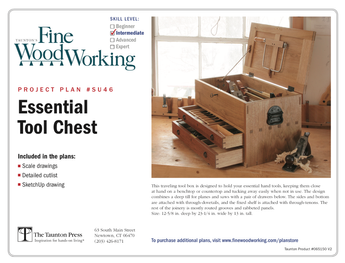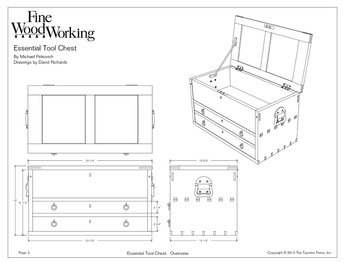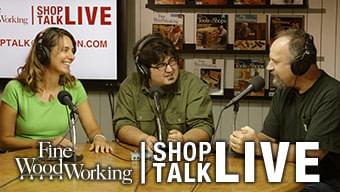Making the Jigs for a particular project
I am new to Fine Woodworking and watched Tom McKenna’s March 20, 2020 video entitled “Beginning Woodworking Plans for Building a Small Stepstool” — in these short videos he notes the use of several jigs to accomplish to various steps/cuts on the tablesaw and the bandsaw. However, the provided plans only show the project itself and I am not sure about making the jigs. It would have been very helpful to include a written plan or direction to make the jigs.














Replies
Our work filter prevents me from opening the file but it's probably a good idea to get in a habit of creating a full size drawing of the piece if it wasn't provided. Patterns are made off of that. Take some 1/2 MDF and stipple the area (pattern) onto the MDF from the full size drawing. Connect the pin holes with a pencil and there's your pattern. Cut it out on the bandsaw.
Stippling: Placing pin holes along the lines close enough, around the area needed for the pattern, that allows you to connect the dots.
I agree that an article that includes jigs should include the making thereof. I was a technical book reviewer for some years as a sideline and one thing that often flipped my switch was the failure to fully define an acronym prior to using it as common speech. BGP = Border Gateway Protocol, MPLS = Multi Protocol Label Switching, etc. Writing a tutorial that contains operations, tools, or jigs not clearly defined fails in the same way. I know this offers no specific cure to your problem but hope the editors will take notice and fix their shortcomings.
*Multiprotocol Label Switching
@user-6476733 Thanks, fixed. That was embarrassing ;-)
Thanks for these replies to my posting but I still do not have any of the "know how" to create the jigs in the article I mentioned
Michael,
The worker in the video gives a pretty good explanation of the job the jigs are designed to do, and that is what's important. The exact dimensions/plans of the parts is less important. For example, the taper cutting jig is intended to hold the desired cut line of the taper parallel to the blade (and the fence, and the travel of the baseplate). Therefore, he attaches the cleats to achieve this once the workpiece is positioned correctly.
In the bandsaw wedge cutting jig he could have been clearer that he is first free hand cutting the wedge shaped pocket in the jig side (the rise/run profile of the desired wedge), then using the jig against the fence when he is slicing the wedges off. The dimensions of the jig parts simply need to fit the stock you're cutting.
The pattern routing jig looks a little clumsy and requires a longish bit extended well above the table. Since the stool side is reasonably large, many woodworkers would simply double-stick tape the pattern to the top of the workpiece and run that through the router table. However, his jig keeps his hands further away from the bit, and that is safer.
Do you have specific questions on any of these jigs ?
Gary
Have you tried emailing FWW and requesting a contact for Tom McKenna or possibly FWW staff could assist. If this is the step stool project, I think the intent was to provide plans for a project that an inexperienced woodworker could make easily without constructing a lot of jigs (but I have not watched the videos).
Second, my suggestion is to attempt to create jigs from an understanding of what they are intended to help with. No jig must be complicated. Jigs can be as simple; simple as a staight board to create a straight edge to a simple shooting board to permit precise handplane trimming to a simple hold-down jig to allow you to work with a small piece. Don't be intimidated by thinking that a jig is forever. A jig is just something that permits to you do some repetitive work or to just allow you to do a single job better or safer.
If the project is the step stool, the main "jigs" which might be relevant appear to be a pattern to permit you to route a duplicated shape on the router and maybe a mortise guide.
I didn't watch these videos completely so don't know what direction was given for cutting mortises or pattern routing, but I think these 2 processes could be done without jigs or patterns unless you plan to make many stools.
Alternatively, there are many videos on YouTube which would contribute to your knowledge of how to make jigs for these 2 steps in the project. (Of course, watch out for ideas that you don't feel comfortable with or seem out of line with other ideas.)
Again, I think the reason no direction on jigs was provided is because jigs would not absolutely be needed to make this project as a one-up piece.
This was very helpful -- thank you!!
T he first is simply a template that is half the dimensions of the leg and after drilling to line up the hole of the legs you lay out whatever curve you like, lay out the pattern on one side of the leg, flip it over and repeat on the same face. After bandsawing you can attach the template with double side tape and use your router table making sure you feed it in the right direction, Flip the piece over and reattach the template and feed the router again. you don't need to use a sled like he does.
The second is a piece of plywood wider than the leg. As he does, put the bottom of the leg on the edge, slide the top over to your desired angle and put the stop blocks in place. As mentioned in the video you'll to reposition the stop blocks to cut the other side.
What jigs are you specifically looking for? Can you share the links and timecode?